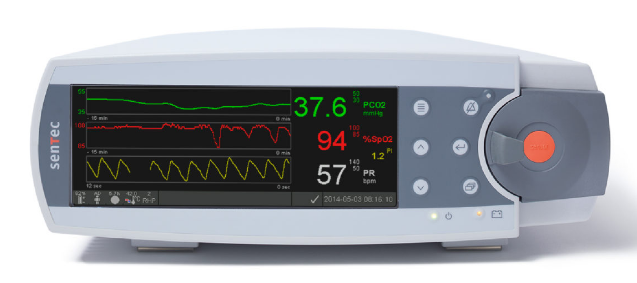Transcutaneous paCO2 Monitoring
From Guide to YKHC Medical Practices
Transcutaneous CO2 (TC-CO2) monitors function by measuring the CO2 which diffuses out the skin. Modern TC-CO2 monitors are a highly accurate, non-invasive method for estimating paCO2.[1]
Primary Purpose
YKDRH obtained TC-CO2 monitors for the purpose of monitoring paCO2 trends in patients receiving high-flow nasal cannula or non-invasive ventilation (i.e. CPAP/BiPAP). This was necessary because end-tidal CO2 monitoring is not compatible with these interventions.
Important Points
- Applicable for all age groups (including extremely premature neonates).
- Initial reading requires approximately five minutes to establish.
- TC-CO2 is substantially more accurate than peripheral venous CO2 for estimating paCO2.[1]
- Because CO2 takes several minutes to diffuse out of the skin, the displayed TC-CO2 reading at any given time reflects the paCO2 from 2-4 minutes prior.
- The tracing is a flat line (rather than the waveform created by exhaled air).
- TC-CO2 is used to follow paCO2 trends; it DOES NOT measure instantaneous levels. Therefore, TC-CO2 IS NOT an acceptable substitute for ET-CO2 in situations such as:
- Confirmation of ET-tube placement.
- CPR (neither for CPR adequacy nor ROSC identification).
- Respiratory monitoring during sedation.
- Any situation where monitoring for apnea or any rapid changes in paCO2.
- The accuracy of end-tidal CO2 as an estimate of paCO2 is largely dependent upon how closely a patient's lung function matches an ideal lung. For patients who are intubated for non-respiratory issues, their lung function should pretty closely approximate an ideal lung, and thus end-tidal CO2 should estimate paCO2 with reasonable accuracy. But for patients with lung processes which create V/Q mismatches, end-tidal CO2 is not a good estimate of paCO2. In such situations, TC-CO2 provides a MUCH MORE ACCURATE estimate paCO2.[1] Thus, if paCO2 requires monitoring in patients with ARDS, bronchiolitis, pneumonia, etc., TC-CO2 should be considered regardless of the type of respiratory support the patient is receiving (i.e. none, high-flow, or intubated). In such a situation, an intubated patient might be monitored with end-tidal CO2 to watch for apnea and TC-CO2 to assess adequacy of ventilation over time.
Device
YKDRH has acquired the Sentec Digital Monitoring System.
The Sentec devices provides monitoring of:
- Instantaneous oximetry (with an adjustable duration trend line)
- Instantaneous heart rate (with an adjustable duration trend line)
- Delayed paCO2 (with an adjustable duration trend line)
Resources
Instructional Videos:
- Sensor Application Neonatal for the Sentec Digital Transcutaneous Monitoring System
- Sensor Application Adult Cheek for the Sentec Digital Transcutaneous Monitoring System
- Sensor Application Adult Upper Arm for the Sentec Digital Transcutaneous Monitoring System
- Changing the Sensor Membrane for the Sentec Digital Transcutaneous Monitoring System
- Sentec Digital Transcutaneous Monitoring System Demonstration
PubMed Searches:
REFERENCES
- ↑ 1.0 1.1 1.2 Nassar BS, Schmidt GA. Estimating Arterial Partial Pressure of Carbon Dioxide in Ventilated Patients: How Valid Are Surrogate Measures? Ann Am Thorac Soc. 2017 Jun;14(6):1005-1014. doi: 10.1513/AnnalsATS.201701-034FR. PMID: 28570147.
